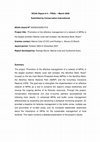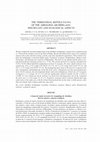Papers by Guilherme Fraga Dutra
Abrolhos: challenges for the conservation and sustainable development of the area that encompasse... more Abrolhos: challenges for the conservation and sustainable development of the area that encompasses the largest marine biodiversity in the southern Atlantic Warning The contents of this site is subject to the French law on intellectual property and is the exclusive property of the publisher. The works on this site can be accessed and reproduced on paper or digital media, provided that they are strictly used for personal, scientific or educational purposes excluding any commercial exploitation. Reproduction must necessarily mention the editor, the journal name, the author and the document reference. Any other reproduction is strictly forbidden without permission of the publisher, except in cases provided by legislation

Project title: " Promotion of the effective management of a network of MPAs in the largest s... more Project title: " Promotion of the effective management of a network of MPAs in the largest southern Atlantic coral reef complex: the Abrolhos Bank, Brazil. " Summary The project " Promotion of the effective management of a network of MPAs in the largest southern Atlantic coral reef complex: the Abrolhos Bank, Brazil " focused on the two main Marine Protected Areas (MPAs) in the Abrolhos Bank: the Abrolhos Marine National Park (AMNP) and the Corumbau Extractive Reserve (CER). The goal was to strengthen the implementation of an effective network of MPAs as a tool to conserve the region's unique biodiversity and reverse the ongoing decline of its fisheries resources. Through this project, Conservation International (CI) and in-country partners accomplished the following main results: (1) enhanced MPAs and buffer zones management effectiveness by expanding and advancing a biological monitoring program; (2) provided a baseline for fisheries management in the buffe...
Boletim Do Instituto De Pesca, 2015
The objective of this study was to evaluate the management and economic return of the seabob shri... more The objective of this study was to evaluate the management and economic return of the seabob shrimp (Xiphopenaeus kroyeri) fisheries in Caravelas, Bahia, Brazil. Monitoring data of fisheries landings from October 2010 to November 2011 were analyzed. An increase in the number of vessels that operated in the trolling fisheries in the period subsequent to the season closure was observed, as well as greater total catch compared to the remaining days of the year. Consequently, the price paid for the shrimp to the fisherman dropped 35% compared to the period before the closure, causing an economic loss to the community. An increase of the catch-per-unit-effort (CPUE) was observed in the period following the closure season, as well as a lower cost for shrimp capture, which incentivizes fishing regardless of the lower price.
Field Actions Science Reports the Journal of Field Actions, Sep 1, 2011
Vice-President of the Associação Mãe dos Extrativistas da RESEX Canavieiras (Extractivists' Mothe... more Vice-President of the Associação Mãe dos Extrativistas da RESEX Canavieiras (Extractivists' Mother Association for the Canavieiras Extractive Reserve).

Brazilian Journal of Biology, 2002
We have studied the terrestrial reptile fauna of the Abrolhos Archipelago (a group of five island... more We have studied the terrestrial reptile fauna of the Abrolhos Archipelago (a group of five islands located ca. 70 km off the southern coast of the State of Bahia, Brazil) and analyze here some of its ecological aspects such as diet, thermal ecology, activity, and some reproductive parameters. Three lizards comprise the archipelago's terrestrial reptile fauna: Tropidurus torquatus (Tropiduridae), Mabuya agilis (Scincidae), and Hemidactylus mabouia (Gekkonidae). The first two are diurnal and the latter is crepuscular/nocturnal (initiating activity at ca. 17:30). The activity period of T. torquatus extended from 5:30 to 18:30 h. Mean field body temperatures of active T. torquatus, M. agilis, and H. mabouia were, respectively, 34.0 ± 3.7ºC (range 23.8-38.0ºC; N = 75), 34.5 ± 2.2ºC (range 30.8-37.0ºC; N = 6), and 26.3 ± 1.1ºC (range 24.8-28.0ºC; N = 8). The predominant prey items in the diet of T. torquatus were ants, coleopterans, and hemipterans. In the diet of M. agilis, coleopter...
Journal of Natural History, 2008
... years after completion of the field work of the present study a severe impact occurred in the... more ... years after completion of the field work of the present study a severe impact occurred in theremnant of the ... Realized niche overlap, resource abundance and intensity ... In Lizard ecology: studies of a model organism , Edited by: Huye, R. B, Pianka, E. R and Schoener, TW 261280 ...
Journal of Herpetology, 2004
... New Cnemidophorus (Squamata: Teiidae) from Bahia State, Northern Brazil. ... Pedro Luiz Vieir... more ... New Cnemidophorus (Squamata: Teiidae) from Bahia State, Northern Brazil. ... Pedro Luiz Vieira Peloso 1 , 3 , 4 , Carlos Frederico Duarte Rocha 2 , Silvia Eliza Pavan 1 , 3 ... and microhabitat use by the endemic whiptail lizard, Cnemidophorus nativo (Teiidae), in a restinga habitat ...
Journal of Helminthology, 2004
A sample of 101 specimens of the unisexual whiptail lizard Cnemidophorus nativo (Squamata; Teiida... more A sample of 101 specimens of the unisexual whiptail lizard Cnemidophorus nativo (Squamata; Teiidae) from a coastal site in Bahia State, Brazil were examined for the presence of endoparasites. Of these, 35 (34.7%) harboured helminths. Six helminth species were recovered from C. nativo, including five nematodes (Physaloptera retusa, Physalopteroides venancioi, Subulura lacertilia, Skrjabinelazia intermedia and Parapharyngodon sp., and one cestode (Oochoristica ameivae), all representing new host records. Most lizards were infected by a single species of helminth and none by more than three. Infection rates were neither significantly influenced by host body size nor by environmental factors. The results are compared with data from studies on other whiptail species in both South and North America.
Herpetologica, 2011
... Southwestern Naturalist 37:280286. Huang, WS 2007. Ecology and reproductive patterns of the ... more ... Southwestern Naturalist 37:280286. Huang, WS 2007. Ecology and reproductive patterns of the agamid lizard Japalura swinhonis on an east Asian island, with comments on the small clutch sizes of island lizards. Zoological Science 24:181188. ...

Field Actions Science Reports the Journal of Field Actions, Sep 1, 2011
Resumo. A Região dos Abrolhos, que se estende entre o sul do estado da Bahia e norte do Espírito ... more Resumo. A Região dos Abrolhos, que se estende entre o sul do estado da Bahia e norte do Espírito Santo, abriga a maior biodiversidade marinha conhecida em todo o Atlântico Sul. As duas principais atividades econômicas da região são a pesca e o turismo, ambas claramente dependentes do meio ambiente. Nesse contexto, os aspectos ambientais, sociais e econômicos são indissociáveis e devem ser a base de políticas de desenvolvimento sustentável para a região. O presente artigo resgata algumas experiências que buscam aliar a conservação e o desenvolvimento sustentável em Abrolhos. Destacam-se a criação de áreas protegidas, principalmente o Parque Nacional Marinho dos Abrolhos, em 1983, e as Reservas Extrativistas Marinhas Corumbau e Canavieiras, em 2000 e 2006, respectivamente; a experiência bem sucedida de uso sustentado dos recursos pesqueiros na RESEX do Corumbau, através inclusive da implementação de áreas de exclusão de pesca; e as conquistas sociais para a população da RESEX Canavieiras, fomentadas pelo estabelecimento de uma rede de organizações comunitárias. Mas a Região dos Abrolhos ainda enfrenta grandes ameaças, das quais a principal é a sobrepesca. Por isso, para fortalecer as ações de conservação na região, as iniciativas futuras de trabalho incluem, entre outras, uma grande ampliação na rede de áreas marinhas protegidas e a criação de um Fundo de Conservação Marinha para dar continuidade às ações em curso.
Uploads
Papers by Guilherme Fraga Dutra